Explorer Ernest Shackleton's last ship found off Labrador's south coast, says expedition
CBC
Wed, June 12, 2024
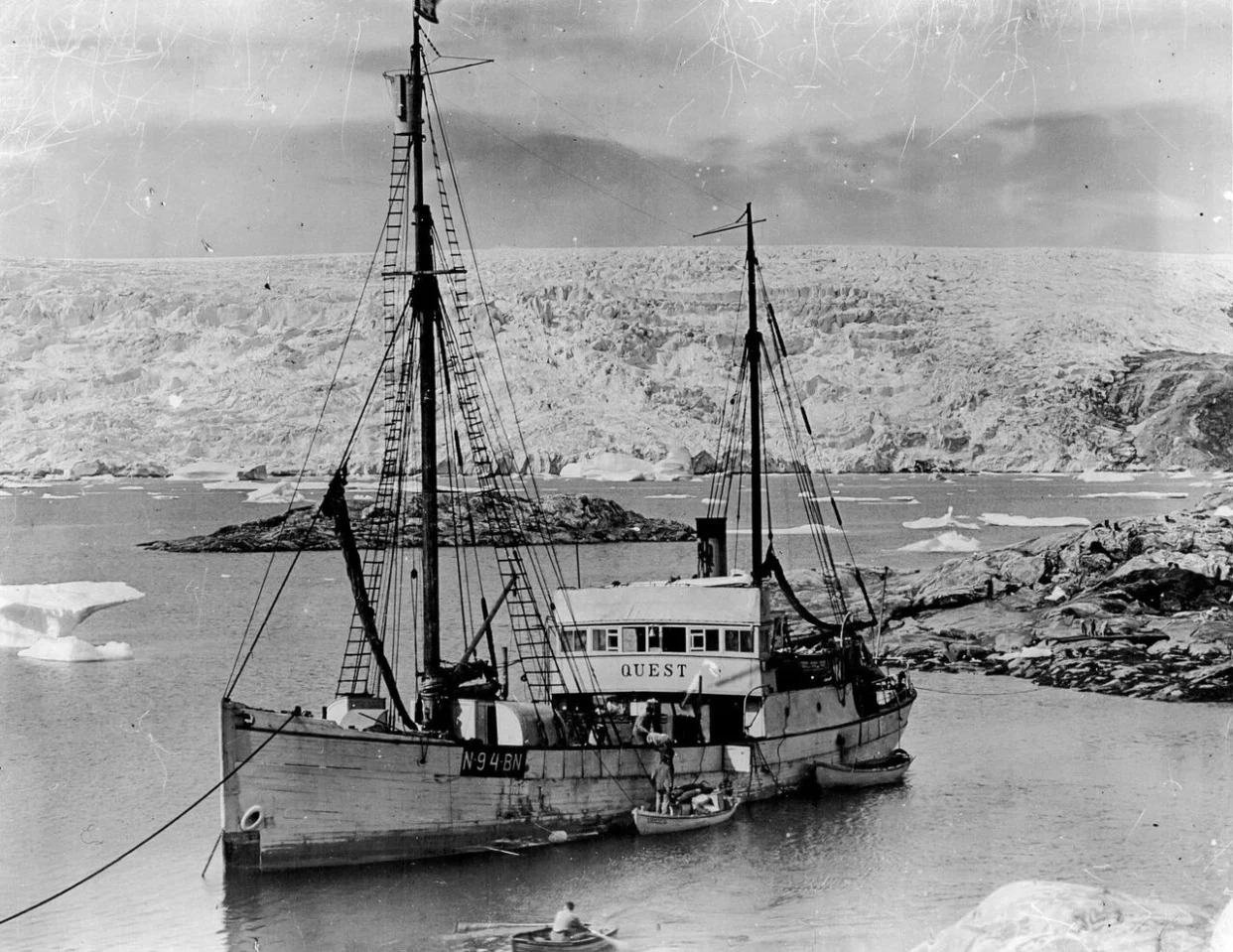
Royal Canadian Geographical Society announced on Tuesday it found polar explorer Sir Ernest Shackleton’s ship Quest 390 metres off the coast of Newfoundland and Labrador. (Royal Canadian Geographical Society/X - image credit)

Royal Canadian Geographical Society announced on Tuesday it found polar explorer Sir Ernest Shackleton’s ship Quest 390 metres off the coast of Newfoundland and Labrador.
The Royal Canadian Geographical Society says it has found polar explorer Sir Ernest Shackleton’s final ship, the Quest, off Labrador's south coast, 390 metres underwater. (Royal Canadian Geographical Society/X)The last vessel helmed by famed Anglo-Irish explorer Sir Ernest Shackleton — lost for more than 60 years — has been discovered on the ocean floor, less than half a kilometre off Labrador's south coast, says the Royal Canadian Geographical Society.
Expedition leader John Geiger, the society's CEO, said the wreck was found in the Labrador Sea, lying at a depth of 390 metres. He added it was in the vicinity of where the ship had been reported to have sunk.
''This is a very important vessel. Historically it was the final expedition ship of Sir Ernest Shackleton," he said Wednesday morning at a news conference at the Marine Institute in St. John's. "As many of you know, he died on this ship on his final expedition of the Shackleton–Rowett expedition, which set out to initially explore Canada."
Using sonar operated by Marine Institute staff, the international team say they found the Quest off the coast near Battle Harbour, on Sunday, five days into its expedition, which left June 5.
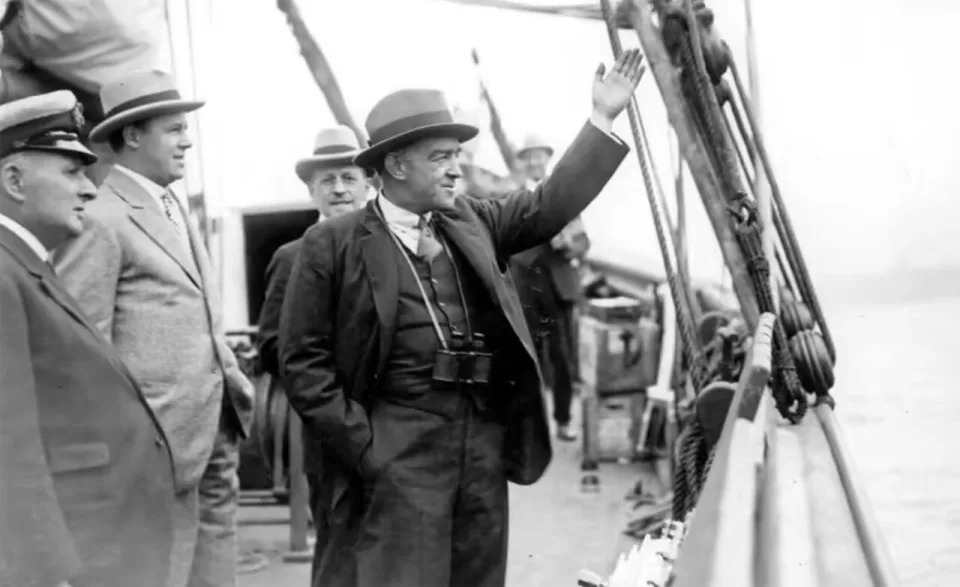
Shackleton died at the age of 47 aboard the Quest in 1922 near island of South Georgia in the South Atlantic.
Shackleton died at the age of 47 aboard the Quest in 1922 near island of South Georgia in the South Atlantic. (Getty Images)
Shackleton died of a heart attack aboard the Quest in 1922, at the age of 47, near the island of South Georgia in the South Atlantic during a voyage to Antarctica.
The Quest, a schooner-rigged steamship, remained in service for decades, including as a minesweeper in World War Two and as a sealing vessel. In 1962 it struck ice and sank off Labrador's coast.
Search director David Mearns said he's certain the vessel the team found is the Quest.
"It's largely intact. We'll be very excited for the second phase of the expedition, which is to actually photograph and visually document the shipwreck and the artifacts," said Mearns.
Mearns hopes that will take place later this summer.
They were searching in an area of about 24 square nautical miles, he said.
"That search box was determined by our analysis of the uncertainty of the navigation position where the ship was lost. We only had a single position, just one position, for the sinking."
Mearns said the team had to determine how accurate the position was.
"Because when we go out searching for shipwrecks we don't search for X's. We don't go to spots. We search for boxes. And those boxes have to give us the highest possible chance of finding the shipwreck."
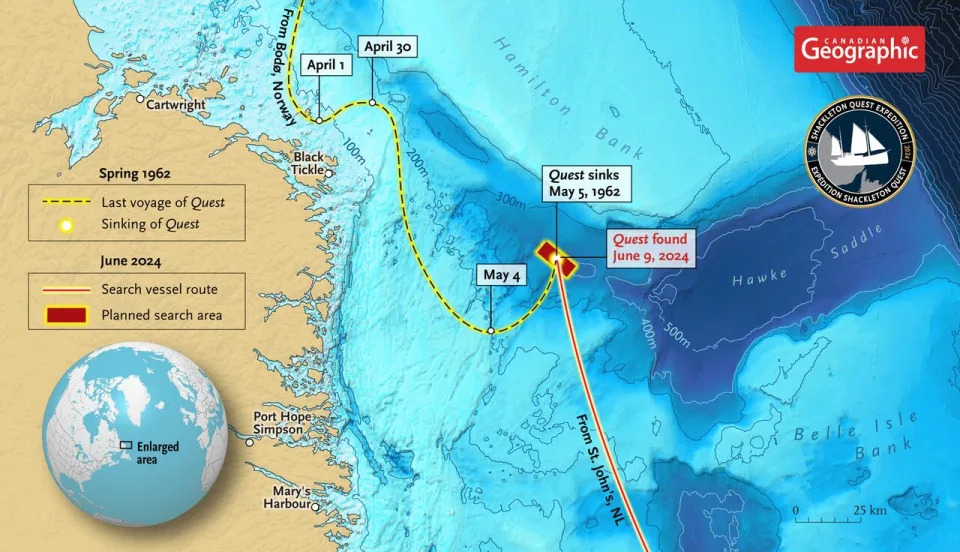
Expedition leader John Geiger, the society's CEO, says the Quest was found in the Labrador sea and near where it was reported to have sank in 1962.
Expedition leader John Geiger, the society's CEO, says the Quest was found in the Labrador Sea, near where it was reported to have sun in 1962. (Royal Canadian Geographical Society)
Shackelton's granddaughter Alexandra Shackleton was a patron of the expedition to find the Quest.
"It is perhaps fitting that the ship should have ended its storied service in Canadian waters. I have long hoped for this day and am grateful to those who made this incredible discovery," she said in the statement.
Traditional Chief Mi'sel Joe of the Miawpukek First Nation, another expedition patron, said he was happy the vessel had been found, noting it had sunk in waters off Mi'kmaw, Innu and Inuit territories.
"I was happy to share local knowledge with the captain and crew of the search vessel ahead of time to find Quest and honoured that Miawpukek Horizon Marine assisted in planning the expedition."
Wreck of the last ship of famed Anglo-Irish explorer Shackleton found off the coast of Canada
Associated Press
Updated Wed, June 12, 2024

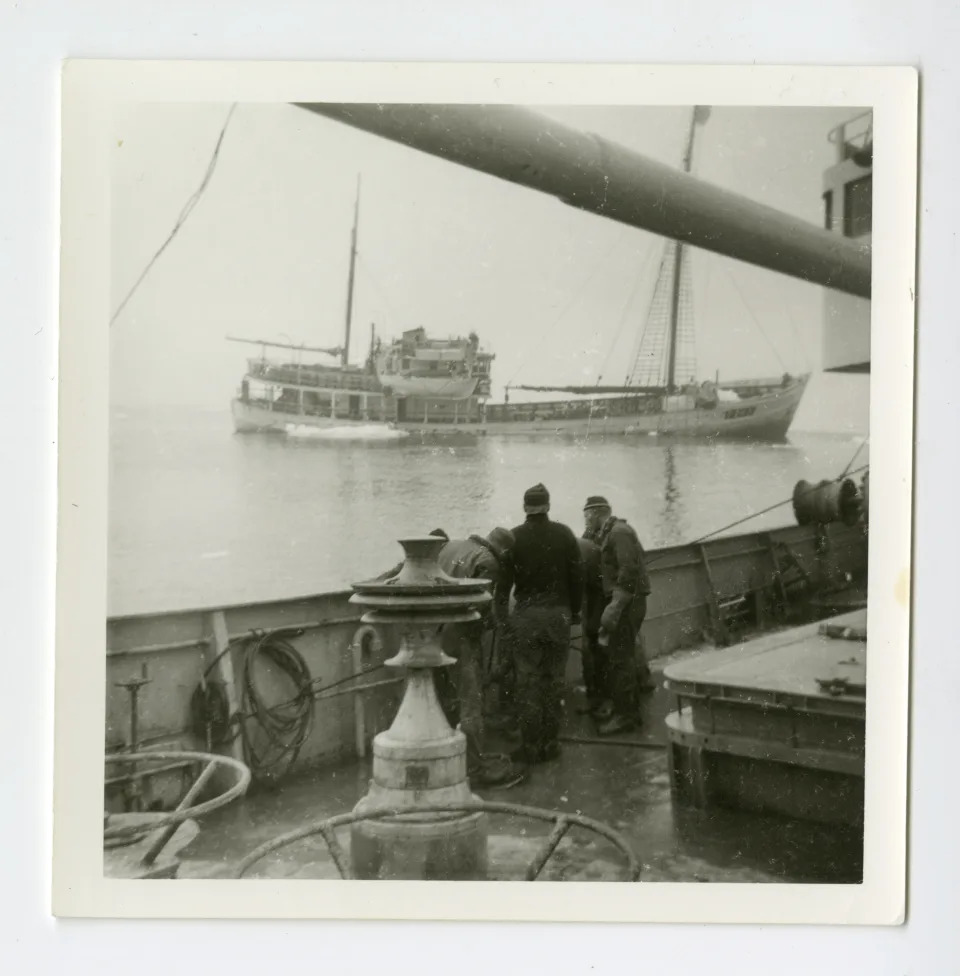
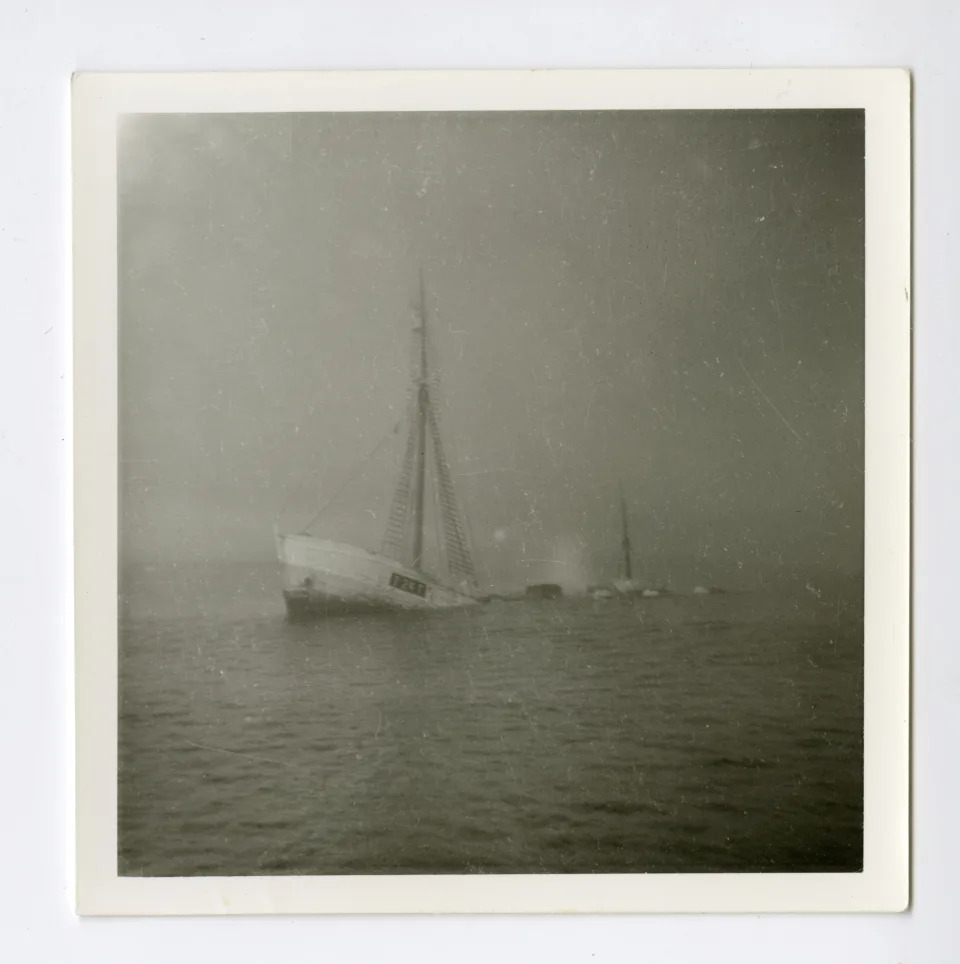
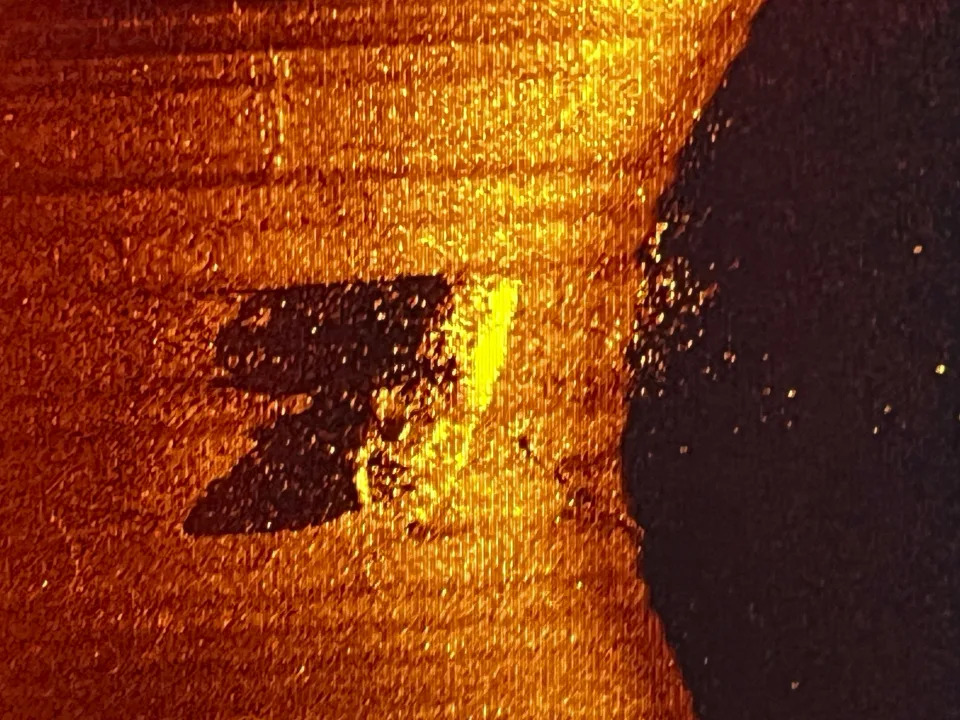
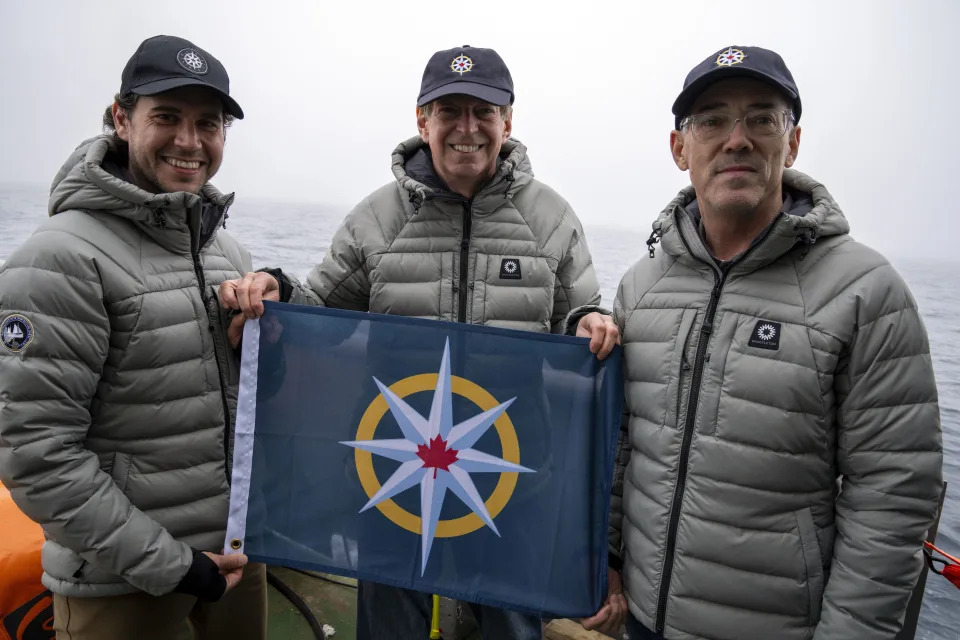
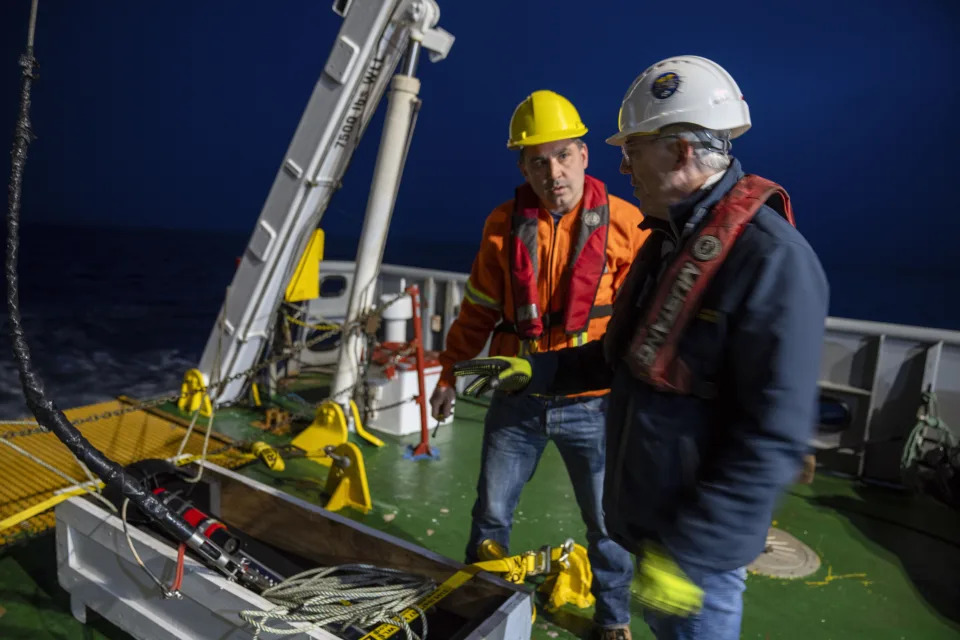
Sir Ernest Shackleton, a noted explorer and writer, is shown as he arrived in New York on the Aquitania, on a hurried business trip to Canada, Jan. 30, 1921. The wreck of the last ship belonging to the famed explorer of Antarctica has been found off the coast of Canada by an international team led by the Royal Canadian Geographical Society. The Quest was found using sonar scans on Sunday evening, June 9, 2024, sitting on its keel under 390 meters of churning, frigid water.
CBC
Wed, June 12, 2024

Royal Canadian Geographical Society announced on Tuesday it found polar explorer Sir Ernest Shackleton’s ship Quest 390 metres off the coast of Newfoundland and Labrador. (Royal Canadian Geographical Society/X - image credit)

Royal Canadian Geographical Society announced on Tuesday it found polar explorer Sir Ernest Shackleton’s ship Quest 390 metres off the coast of Newfoundland and Labrador.
The Royal Canadian Geographical Society says it has found polar explorer Sir Ernest Shackleton’s final ship, the Quest, off Labrador's south coast, 390 metres underwater. (Royal Canadian Geographical Society/X)The last vessel helmed by famed Anglo-Irish explorer Sir Ernest Shackleton — lost for more than 60 years — has been discovered on the ocean floor, less than half a kilometre off Labrador's south coast, says the Royal Canadian Geographical Society.
Expedition leader John Geiger, the society's CEO, said the wreck was found in the Labrador Sea, lying at a depth of 390 metres. He added it was in the vicinity of where the ship had been reported to have sunk.
''This is a very important vessel. Historically it was the final expedition ship of Sir Ernest Shackleton," he said Wednesday morning at a news conference at the Marine Institute in St. John's. "As many of you know, he died on this ship on his final expedition of the Shackleton–Rowett expedition, which set out to initially explore Canada."
Using sonar operated by Marine Institute staff, the international team say they found the Quest off the coast near Battle Harbour, on Sunday, five days into its expedition, which left June 5.

Shackleton died at the age of 47 aboard the Quest in 1922 near island of South Georgia in the South Atlantic.
Shackleton died at the age of 47 aboard the Quest in 1922 near island of South Georgia in the South Atlantic. (Getty Images)
Shackleton died of a heart attack aboard the Quest in 1922, at the age of 47, near the island of South Georgia in the South Atlantic during a voyage to Antarctica.
The Quest, a schooner-rigged steamship, remained in service for decades, including as a minesweeper in World War Two and as a sealing vessel. In 1962 it struck ice and sank off Labrador's coast.
Search director David Mearns said he's certain the vessel the team found is the Quest.
"It's largely intact. We'll be very excited for the second phase of the expedition, which is to actually photograph and visually document the shipwreck and the artifacts," said Mearns.
Mearns hopes that will take place later this summer.
They were searching in an area of about 24 square nautical miles, he said.
"That search box was determined by our analysis of the uncertainty of the navigation position where the ship was lost. We only had a single position, just one position, for the sinking."
Mearns said the team had to determine how accurate the position was.
"Because when we go out searching for shipwrecks we don't search for X's. We don't go to spots. We search for boxes. And those boxes have to give us the highest possible chance of finding the shipwreck."

Expedition leader John Geiger, the society's CEO, says the Quest was found in the Labrador sea and near where it was reported to have sank in 1962.
Expedition leader John Geiger, the society's CEO, says the Quest was found in the Labrador Sea, near where it was reported to have sun in 1962. (Royal Canadian Geographical Society)
Shackelton's granddaughter Alexandra Shackleton was a patron of the expedition to find the Quest.
"It is perhaps fitting that the ship should have ended its storied service in Canadian waters. I have long hoped for this day and am grateful to those who made this incredible discovery," she said in the statement.
Traditional Chief Mi'sel Joe of the Miawpukek First Nation, another expedition patron, said he was happy the vessel had been found, noting it had sunk in waters off Mi'kmaw, Innu and Inuit territories.
"I was happy to share local knowledge with the captain and crew of the search vessel ahead of time to find Quest and honoured that Miawpukek Horizon Marine assisted in planning the expedition."
Wreck of the last ship of famed Anglo-Irish explorer Shackleton found off the coast of Canada
Associated Press
Updated Wed, June 12, 2024






Sir Ernest Shackleton, a noted explorer and writer, is shown as he arrived in New York on the Aquitania, on a hurried business trip to Canada, Jan. 30, 1921. The wreck of the last ship belonging to the famed explorer of Antarctica has been found off the coast of Canada by an international team led by the Royal Canadian Geographical Society. The Quest was found using sonar scans on Sunday evening, June 9, 2024, sitting on its keel under 390 meters of churning, frigid water.
(AP Photo, File)
ST. JOHN'S, Newfoundland (AP) — The wreck of the last ship belonging to Sir Ernest Shackleton, a famous Irish-born British explorer of Antarctica, has been found off the coast of Labrador in Canada, 62 years after it went missing. The wreck was found by an international team led by the Royal Canadian Geographical Society.
The Quest was found using sonar scans on Sunday evening, sitting on its keel under 390 meters (1,280 feet) of churning, frigid water, the society said. Its towering mast is lying broken beside it, likely cracked off as the vessel was sucked into the depths after it struck ice on May 5, 1962.
“I heard that some Americans were interested in finding Quest, and I just had this picture in my mind of a few billionaires on yachts, up in the Labrador Sea,” John Geiger, leader of the Shackleton Quest Expedition and the chief executive of the Royal Canadian Geographical Society, told an audience at the Memorial University’s Marine Institute in St. John’s, Newfoundland, on Wednesday.
“We’ve done it the right way. It’s not about anyone’s ego, it’s about telling great stories and celebrating some of the finest human attributes,” Geiger said.
He called the Quest a historically very important ship.
Shackleton’s death aboard the ship in 1922 marked the end of what historians consider the “heroic age” of Antarctic exploration. The explorer led three British expeditions to the Antarctic, and he was in the early stages of a fourth when he died of a heart attack. He was 47.
The Norwegian-built Quest was a schooner-rigged steamship, and Shackleton bought it specifically to travel to Canada’s High Arctic, Geiger said. But the Canadian government at the time axed those plans, and Shackleton decided to set sail once again for the Antarctic.
He died when it was just off South Georgia, east of the Falkland Islands in the South Atlantic.
After the explorer’s death, the Quest was used for Arctic research and then returned to its original intended use as a sealing vessel. It sank in 1962, after it was damaged by ice in the Labrador Sea while on a whaling trip.
The vessel appears to be in “incredible condition,” though it was damaged when it slammed into the seabed, Geiger said.
It won’t be brought to the surface — that would be far too expensive, he added — but it will be thoroughly documented and studied. A crew will likely head out some time before the end of summer to begin taking footage of the vessel with a remotely operated vehicle.
In 2022, researchers discovered another one of Shackleton’s ships, the Endurance in 10,000 feet — about 3,000 meters — of icy water, a century after it was swallowed up by Antarctic ice.
A team of marine archaeologists, engineers and other scientists used an icebreaker ship and underwater drones to locate the wreck at the bottom of the Weddell Sea, near the Antarctica Peninsula.
The expedition Endurance22 embarked from Cape Town, South Africa, in early February in a ship capable of breaking through 3-foot (1-meter)-thick ice.
The team, which included more than 100 researchers and crew members, deployed underwater drones that combed the seafloor for two weeks in the area where the ship was recorded to have sunk in 1915.
Shackleton never achieved his ambition to become the first person to cross Antarctica via the South Pole. In fact, he never set foot on the continent during the failed Endurance expedition, though he did visit Antarctica during earlier voyages.
Wreck of polar explorer Shackleton’s last ship found
ST. JOHN'S, Newfoundland (AP) — The wreck of the last ship belonging to Sir Ernest Shackleton, a famous Irish-born British explorer of Antarctica, has been found off the coast of Labrador in Canada, 62 years after it went missing. The wreck was found by an international team led by the Royal Canadian Geographical Society.
The Quest was found using sonar scans on Sunday evening, sitting on its keel under 390 meters (1,280 feet) of churning, frigid water, the society said. Its towering mast is lying broken beside it, likely cracked off as the vessel was sucked into the depths after it struck ice on May 5, 1962.
“I heard that some Americans were interested in finding Quest, and I just had this picture in my mind of a few billionaires on yachts, up in the Labrador Sea,” John Geiger, leader of the Shackleton Quest Expedition and the chief executive of the Royal Canadian Geographical Society, told an audience at the Memorial University’s Marine Institute in St. John’s, Newfoundland, on Wednesday.
“We’ve done it the right way. It’s not about anyone’s ego, it’s about telling great stories and celebrating some of the finest human attributes,” Geiger said.
He called the Quest a historically very important ship.
Shackleton’s death aboard the ship in 1922 marked the end of what historians consider the “heroic age” of Antarctic exploration. The explorer led three British expeditions to the Antarctic, and he was in the early stages of a fourth when he died of a heart attack. He was 47.
The Norwegian-built Quest was a schooner-rigged steamship, and Shackleton bought it specifically to travel to Canada’s High Arctic, Geiger said. But the Canadian government at the time axed those plans, and Shackleton decided to set sail once again for the Antarctic.
He died when it was just off South Georgia, east of the Falkland Islands in the South Atlantic.
After the explorer’s death, the Quest was used for Arctic research and then returned to its original intended use as a sealing vessel. It sank in 1962, after it was damaged by ice in the Labrador Sea while on a whaling trip.
The vessel appears to be in “incredible condition,” though it was damaged when it slammed into the seabed, Geiger said.
It won’t be brought to the surface — that would be far too expensive, he added — but it will be thoroughly documented and studied. A crew will likely head out some time before the end of summer to begin taking footage of the vessel with a remotely operated vehicle.
In 2022, researchers discovered another one of Shackleton’s ships, the Endurance in 10,000 feet — about 3,000 meters — of icy water, a century after it was swallowed up by Antarctic ice.
A team of marine archaeologists, engineers and other scientists used an icebreaker ship and underwater drones to locate the wreck at the bottom of the Weddell Sea, near the Antarctica Peninsula.
The expedition Endurance22 embarked from Cape Town, South Africa, in early February in a ship capable of breaking through 3-foot (1-meter)-thick ice.
The team, which included more than 100 researchers and crew members, deployed underwater drones that combed the seafloor for two weeks in the area where the ship was recorded to have sunk in 1915.
Shackleton never achieved his ambition to become the first person to cross Antarctica via the South Pole. In fact, he never set foot on the continent during the failed Endurance expedition, though he did visit Antarctica during earlier voyages.
Wreck of polar explorer Shackleton’s last ship found
THE TELEGRAPH
Rozina Sabur
Wed, June 12, 2024
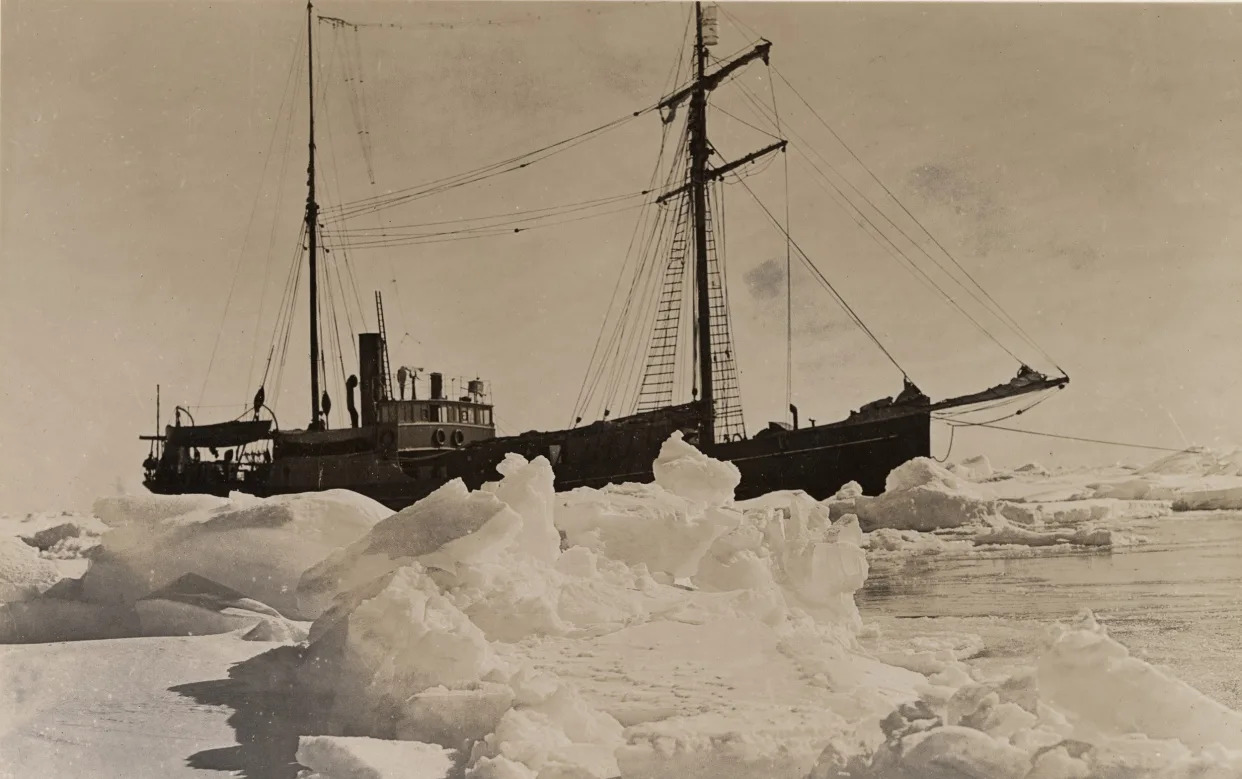
The Quest during the Shackleton-Rowett Antarctic expedition in 1921-1922 - Royal Geographical Society
The ship on which Sir Ernest Shackleton made his final voyage has been rediscovered off the coast of Canada.
Shackleton suffered a fatal heart attack aboard the Quest in 1922, aged 47, while trying to reach the Antarctic for a fourth expedition.
The vessel remained in use for another 40 years until it sank, but its link to the British-Irish adventurer has made the wreck legendary.
Locating Quest represented the “last discovery in the Shackleton story”, said Alexandra Shackleton, his granddaughter.
Shackleton has been lionised as a leading figure of the so-called “heroic age” of Antarctic exploration.
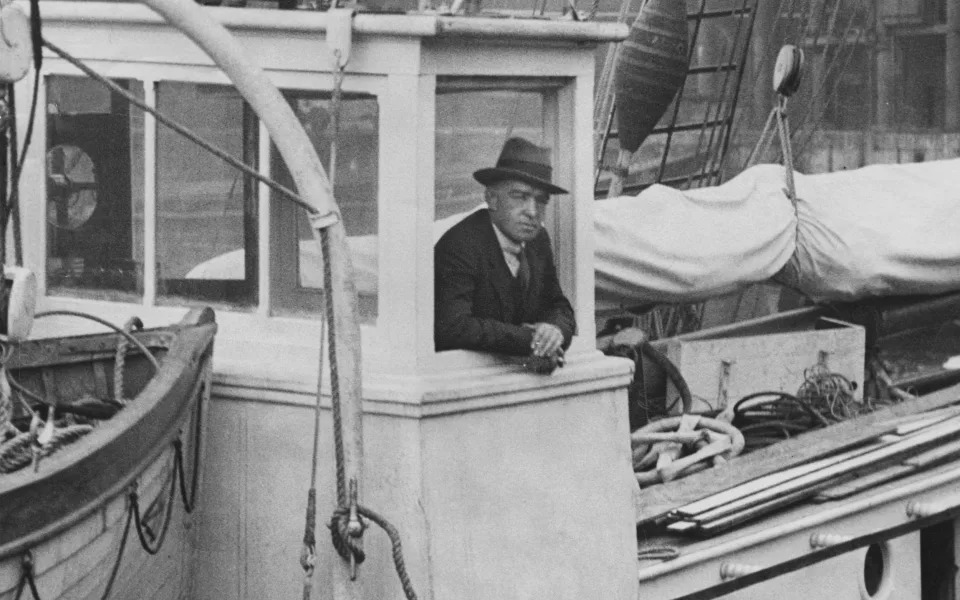
Shackleton leaving London on the Quest on Sept 17, 1921 - Central Press
“His final voyage kind of ended that heroic age of exploration, of polar exploration, certainly in the south,” said David Mearns, who directed the search to find the wreck.
He told the BBC the Quest was “in the pantheon of polar ships”.
The 111ft-long, schooner-rigged steamship was built for seal hunting, but continued sailing in various capacities for decades after Shackleton’s death, including in other exploratory voyages.
By 1962, the ageing vessel had returned to its original purpose and was being used by Norwegian sealers when thick sea ice pierced her hull and sent her to the seafloor off the coast of Newfoundland, Canada.
All its crew were rescued, but the wreck has remained a last mystery of the age of polar explorers, until it was rediscovered in the depths of the Labrador Sea on Sunday by a team led by The Royal Canadian Geographical Society (RCGS).
The ship was located using sonar equipment in 1,280ft of water, sitting almost upright on the seafloor.
Other than damage to its mast, the vessel appears broadly intact.
The RCGS search team had scoured the Quest’s logs, navigation records, photographs and other documents to find its final resting place.
The Quest was found almost exactly where their research had suggested, but its exact coordinates are being withheld.
The vessel is a protected area for marine and wildlife, and the search team said it did not intend to touch the wreck.
However, it is planning a second visit later this year, using a remotely operated vehicle to photograph the ship.
Mr Mearns (R) directing the search for the Quest - Jill Heinerth
Alexandra Shackleton, the closest living relative to the explorer, and a patron of the RCGS survey, said she was thrilled by the discovery.
“For me, this represents the last discovery in the Shackleton story. It completes the circle,” she told the BBC.
Wed, June 12, 2024

The Quest during the Shackleton-Rowett Antarctic expedition in 1921-1922 - Royal Geographical Society
The ship on which Sir Ernest Shackleton made his final voyage has been rediscovered off the coast of Canada.
Shackleton suffered a fatal heart attack aboard the Quest in 1922, aged 47, while trying to reach the Antarctic for a fourth expedition.
The vessel remained in use for another 40 years until it sank, but its link to the British-Irish adventurer has made the wreck legendary.
Locating Quest represented the “last discovery in the Shackleton story”, said Alexandra Shackleton, his granddaughter.
Shackleton has been lionised as a leading figure of the so-called “heroic age” of Antarctic exploration.

Shackleton leaving London on the Quest on Sept 17, 1921 - Central Press
“His final voyage kind of ended that heroic age of exploration, of polar exploration, certainly in the south,” said David Mearns, who directed the search to find the wreck.
He told the BBC the Quest was “in the pantheon of polar ships”.
The 111ft-long, schooner-rigged steamship was built for seal hunting, but continued sailing in various capacities for decades after Shackleton’s death, including in other exploratory voyages.
By 1962, the ageing vessel had returned to its original purpose and was being used by Norwegian sealers when thick sea ice pierced her hull and sent her to the seafloor off the coast of Newfoundland, Canada.
All its crew were rescued, but the wreck has remained a last mystery of the age of polar explorers, until it was rediscovered in the depths of the Labrador Sea on Sunday by a team led by The Royal Canadian Geographical Society (RCGS).
The ship was located using sonar equipment in 1,280ft of water, sitting almost upright on the seafloor.
Other than damage to its mast, the vessel appears broadly intact.
The RCGS search team had scoured the Quest’s logs, navigation records, photographs and other documents to find its final resting place.
The Quest was found almost exactly where their research had suggested, but its exact coordinates are being withheld.
The vessel is a protected area for marine and wildlife, and the search team said it did not intend to touch the wreck.
However, it is planning a second visit later this year, using a remotely operated vehicle to photograph the ship.
Mr Mearns (R) directing the search for the Quest - Jill Heinerth
Alexandra Shackleton, the closest living relative to the explorer, and a patron of the RCGS survey, said she was thrilled by the discovery.
“For me, this represents the last discovery in the Shackleton story. It completes the circle,” she told the BBC.
Ash Routen
Wed, June 12, 2024
The Royal Canadian Geographical Society has announced the discovery of Sir Ernest Shackleton’s ship, the Quest, resting at the bottom of the Labrador Sea. The storied British polar explorer died aboard of a heart attack in 1922. The missing vessel was discovered off the coast of Newfoundland and Labrador, Canada on June 9. It is upright and well-preserved at a depth of 390 meters.
The Quest sank on May 5, 1962, after suffering ice damage while hunting seals. It is located in the traditional waters of the Mi’kmaq, Innu, and Inuit people.
Following Shackleton’s death, the Quest was used in several polar expeditions, such as the 1930-31 British Arctic Air Route Expedition led by the largely forgotten British adventurer Gino Watkins. It served in World War II and eventually did more routine maritime jobs before its demise as a sealing vessel.
“Finding Quest is one of the final chapters in the extraordinary story of Sir Ernest Shackleton,” said John Geiger, the expedition leader and CEO of the Royal Canadian Geographical Society. “Shackleton was known for his courage and brilliance as a leader in times of crisis. The tragic irony is that his was the only death to take place on any of the ships under his direct command.”
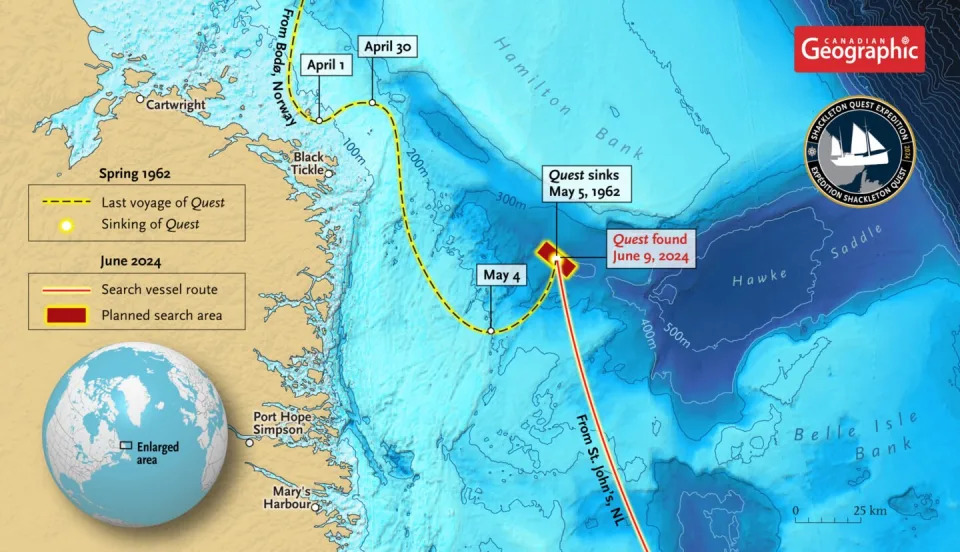
A map illustrates Quest’s final voyage and the search area in the Labrador Sea. Map: Chris Brackley/Can Geo
Painstaking research pinpointed the ship
The search team, led by renowned shipwreck hunter David Mearns, consisted of many international experts. Through meticulous research, including analysis of historical documents, ships’ logs, and weather data, lead researcher Antoine Normandin identified the Quest’s location with impressive precision.
Mearns confirmed the find, stating, “Data from high-resolution side-scan sonar imagery corresponds exactly with the known dimensions and structural features of this special ship and is also consistent with events at the time of the sinking.”
The Quest embarked on the Shackleton-Rowett Expedition from London on September 17, 1921. Shackleton referred to it as his “swan song,” and he died unexpectedly aboard on Jan. 5, 1922, while the ship was anchored at Grytviken Harbour, South Georgia.
In her final voyage, the Quest became trapped and crushed by ice, ultimately sinking after Captain Olav Johannessen and his crew evacuated. Johannessen noted the ship’s last recorded coordinates in a telegram.
The search for the Quest was not without its challenges. The team faced mechanical issues and a tight schedule, but persistence paid off. On June 9, after an extensive sonar scan, the Quest was found 2.5km from its last reported position.
The next phase of work will involve a detailed survey of the wreck using remotely operated vehicles. This will hopefully reveal the ship’s name on the wheelhouse and further illuminate Shackleton’s enduring legacy.
The post Ernest Shackleton’s Lost Ship Found in Labrador Sea appeared first on Explorersweb.
No comments:
Post a Comment